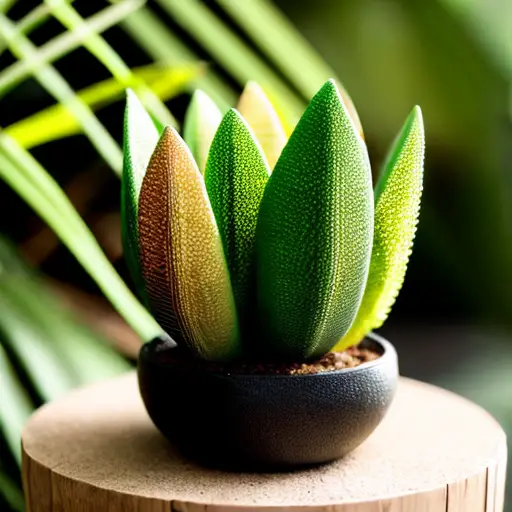Understanding Cycads: An Introduction to These Ancient Plants
Welcome, fellow plant enthusiasts, to the fascinating world of cycads! These prehistoric beauties have been around for millions of years, making them the true elders of the plant kingdom. Now, I know what you're thinking - how on earth do we care for these ancient beings? Fear not, my friends, for I am here to shed some light on the matter. First things first, cycads are not your typical houseplants; they require a bit of extra attention. Think of them as the divas of the plant world, demanding just the right amount of light, water, and nutrients. So, grab your gardening gloves and get ready to embark on a journey through time as we unravel the secrets of nurturing these magnificent cycads!
Creating the Ideal Environment: Providing the Right Conditions for Cycad Growth
An interesting fact about caring for cycad plants is that they have a unique reproductive process. Cycads are dioecious, meaning they have separate male and female plants. To successfully propagate cycads, it is necessary to collect pollen from the male plant and transfer it to the female plant. This can be done by carefully removing the male cone, collecting the pollen, and then brushing it onto the female cone. This fascinating process mimics the pollination methods used by ancient insects and is a testament to the cycad's evolutionary history, dating back millions of years.
Picture this: a lush, tropical paradise where cycads thrive in all their glory. Creating such an environment for these ancient plants is not as daunting as it may seem. Firstly, let's talk about sunlight. Cycads adore bright, indirect light, so find them a cozy spot near a window where they can bask in the gentle rays. Next up, temperature. These plants prefer a warm climate, so keep them away from chilly drafts and ensure the room stays above 60 degrees Fahrenheit. Now, let's talk hydration. Cycads are not fans of soggy roots, so water them sparingly, allowing the soil to dry out slightly between waterings. Lastly, don't forget to feed your cycads with a balanced fertilizer to keep them nourished and thriving. With a little bit of effort and a touch of green-thumb magic, you'll create the perfect haven for your cycad companions. Happy growing!
Nurturing Cycads: Essential Care Tips for Healthy Growth and Development

Nurturing cycads is like tending to a living relic from the past, and it requires a delicate touch and a keen eye for detail. First and foremost, let's talk about soil. These ancient plants prefer well-draining soil that mimics their natural habitat. A mix of sandy soil, perlite, and organic matter will do the trick. Remember, cycads are not fans of wet feet, so ensure the soil is never waterlogged.
Now, let's dive into watering. Cycads have a unique relationship with water, as they prefer to be slightly on the drier side. It's best to water them deeply but infrequently, allowing the soil to dry out between waterings. Overwatering can lead to root rot, which is a big no-no in the world of cycad care. So, resist the temptation to shower them with love and keep their watering routine on the conservative side.
When it comes to light, cycads are sun worshippers, but they prefer a bit of shade to protect their delicate fronds. Find a spot for them where they can bask in bright, indirect light for a good portion of the day. If you notice their leaves turning yellow or brown, it may be a sign that they're getting too much direct sunlight, so adjust accordingly.
Feeding your cycads is also crucial for their overall health and growth. These plants benefit from a slow-release, balanced fertilizer that provides them with the necessary nutrients. Apply the fertilizer during the growing season, typically spring and summer, following the package instructions for the appropriate dosage.
Lastly, keep an eye out for pests. While cycads are generally hardy, they can fall victim to pesky insects like scale or mealybugs. Regularly inspect your plants for any signs of infestation, such as sticky residue or tiny crawling critters. If you spot any unwelcome visitors, treat them promptly with an organic insecticide or a gentle soap and water solution.
Remember, nurturing cycads is a labor of love, and with the right care, these ancient plants will reward you with their timeless beauty and resilience. So, roll up your sleeves, put on your gardening gloves, and embark on this prehistoric journey of cycad care. Happy nurturing!
Troubleshooting Common Issues: Identifying and Addressing Problems in Cycad Care
Fun fact: Did you know that cycad plants have been around for over 300 million years, making them one of the oldest living plant species on Earth? When it comes to caring for these ancient plants, one interesting fact is that they are highly adaptable to different environments. While they prefer well-draining soil and moderate sunlight, cycads can also tolerate drought conditions and even grow in rocky or sandy areas. So, if you're looking for a low-maintenance yet fascinating plant to care for, a cycad might be the perfect choice!
Even the most experienced plant parents can encounter a few bumps in the road when caring for cycads. But fear not, my fellow green thumbs, for I am here to help troubleshoot common issues that may arise. One common problem is yellowing or browning leaves, which can indicate overwatering or too much direct sunlight. Adjust your watering routine and find a spot with slightly less intense light to remedy this. Another issue to watch out for is crown rot, which occurs when water accumulates in the center of the plant. To prevent this, ensure proper drainage and avoid excessive watering. Lastly, if you notice stunted growth or a lack of new fronds, it may be a sign of nutrient deficiency. Consider adjusting your fertilization routine or consulting a plant expert for guidance. Remember, with a little detective work and some TLC, you'll be able to address these common problems and keep your cycads thriving. Happy troubleshooting!

